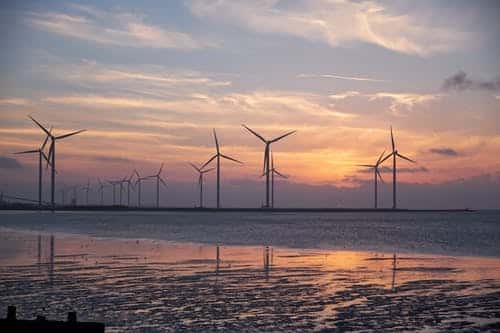U.S. Added 13.4 Gigawatts of Onshore Wind in 2021: DOE

Wind generation represented 32 percent of total U.S. energy capacity growth last year, according to an Aug. 16 news release from the U.S. Energy Department. The sector employs 120,000 people and currently supplies adequate energy to power about 40 million households. The agency issued three reports discussing the onshore utility-scale, offshore utility-scale, and distributed wind market segments.
The U.S. onshore wind sector continued to grow last year and accounts for more than 9 percent of the total electricity supply in the country. The total U.S. onshore cumulative capacity is now 135.9 gigawatts, placing it second in the global market, behind China, which has roughly 338.3 gigawatts capacity. The onshore segment added more than 13.4 gigawatts in 2021, attributed to improvements in costs and technology alongside supportive federal and state-level policies. The new capacity addition is sufficient to power over 4 million households and represents a $20 billion investment in new wind power. The average capacity factor for land-based wind projects is now 35 percent. The capacity factor refers to a project’s actual generation relative to its theoretical maximum output, which can be influenced by factors such as turbine technology and the wind potential at a development site. Wind energy penetration is higher in midcontinent areas that house a considerable amount of capacity. Wind accounts for more than 50 percent of in-state generation in Iowa and South Dakota and 30 percent in Kansas, North Dakota, and Oklahoma.
The offshore wind pipeline in 2021 reached nearly 40 gigawatts, a 13.5 percent increase from 2020. That pipeline includes 932 megawatts under construction and 18.5 gigawatts in the permitting phase. In the last year, the Biden administration has significantly expanded offshore wind development, auctioning six new leases in New York Bight, two new leases in Carolina Long Bay, as well as leasing new areas in California, the Gulf of Mexico, Central Atlantic, Oregon, and the Gulf of Maine. Distributed wind accounted for 1,075 megawatts across the US and added 11.7 megawatts of new distributed wind energy capacity in 2021.
The U.S. at the end of 2021 had a record-high 247 gigawatts of wind in transmission interconnection queues, including 77 gigawatts from offshore projects. About 73 gigawatts entered the queue in 2021, with roughly one-third from offshore wind farms.
The recently enacted Inflation Reduction Act extends incentives to boost renewable energy generation and provides greater market certainty than developers have had in recent years. The act offers long-term extensions of critical tax incentives and supports the construction of high-voltage transmission lines. It also includes new production tax credits for domestic manufacturing and the supply of wind components and equipment. According to the 2021 wind market reports, wind power is proving an important source of clean, cheaper energy generation that will meet President Biden’s goals of 100 percent clean electricity by 2035 and a net zero economy by 2050.
EnerKnol Pulses like this one are powered by the EnerKnol Platform—the first comprehensive database for real-time energy policy tracking. Sign up for a free trial below for access to key regulatory data and deep industry insights across the energy spectrum.
ACCESS FREE TRIAL


